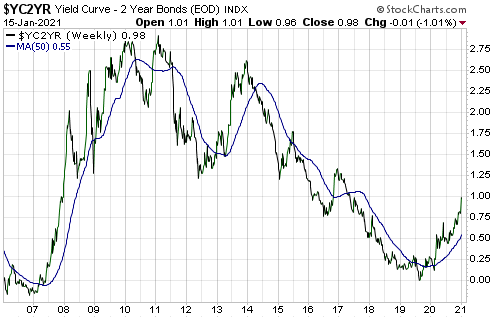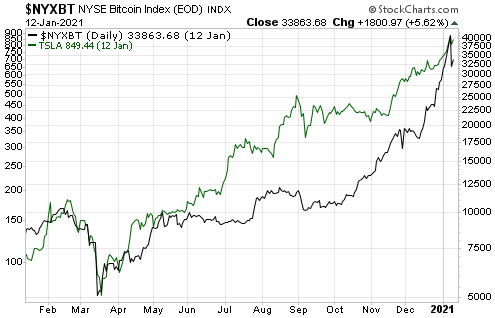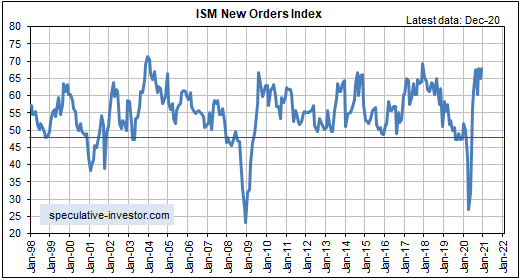[This post is an excerpt from a commentary published at TSI on 17th January 2021]
The US yield curve, represented on the following weekly chart by the spread between the 10-year T-Note yield and the 2-year T-Note yield, has been steepening since the third quarter of 2019. Moreover, the pace of the steepening is accelerating.
A steepening of the yield curve can be primarily driven by decreasing yields on short-dated treasuries or increasing yields on long-dated treasuries. The former results from a general increase in the desire to hold the most liquid and lowest-risk financial assets, such as cash and T-Bills. It is bullish for gold and bearish for commodities and most equity sectors. The latter results from a general increase in inflation expectations. It is also bullish for gold but is more bullish for commodities and certain equity sectors.
The steepening that occurred from the third quarter of 2019 through the first half of 2020 was driven by declining yields on short-dated treasuries, but the steepening that has occurred since August-2020 was driven by rising yields on long-dated treasuries, that is, by rising inflation expectations.
Given what the US government and the Fed have done and plan to do, it shouldn’t be a surprise to anyone that inflation expectations are in a rising trend and that the trend is accelerating. Of particular significance, President-elect Biden has proposed a new “stimulus” package with a US$1.9 trillion price tag, and it is well known that this spending package will be followed by an infrastructure bill that probably will involve another $1-$2 trillion of additional spending. Also, we have statements from the Fed to the effect that now is not the time to be talking about reducing the monetary accommodation and that there won’t be any tightening until an inflation problem is obvious to all.
The Fed could try to suppress one of the symptoms of a burgeoning inflation problem by attempting to control the yield curve, that is, by ramping-up its purchases of long-dated treasuries with the aim of lowering yields at the long end of the curve. However, that would amount to creating more money out of nothing in an effort to address a problem caused by creating too much money out of nothing. Even by the Fed’s own standards this would be counterproductive.
The bottom line is that there will be a lot more inflation and a further large increase in inflation fear before there is a realistic chance of a deflation scare.
 Print This Post
Print This Post



